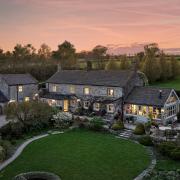Samantha Gibson of Bettys & Taylors joins a group of volunteers helping to protect the landscape by planting trees in the Yorkshire Dales.

A shiny, silver kettle steams away high up on a sun-drenched hillside. A snow-capped mountain gleams in the distance and on every side of us are wooden stakes and soft green tubes housing some very small, very precious saplings that are going to help secure the future of this beautiful landscape.
We’re here planting trees with the National Trust as, thanks to the Bettys Trees for Life campaign, we’ve committed to plant 20,000 trees in Langstrothdale as part of the Trees in the Dales project to restore a more natural habitat to the area and play a part in flood mitigation.
Found in the upper part of Wharfedale, Langstrothdale is a sharply sloping patchwork of hay meadow, blanket bog and upland ash woodland. The dale overlooks the village of Buckden and the River Wharfe, which meanders along the valley bottom.
From Buckden it’s a steep climb to the top, but on the way National Trust Ecologist, Peter Welsh, explains why we are here and the importance of what we’re doing. In short, the landscape needs a bit of TLC. Many years of overgrazing by sheep, the loss of hectares of woodland and the degeneration of peatland has caused the area, and the people who rely on it, to become vulnerable to the impact of climate change.

Recent changes in rainfall patterns have led to higher peak river flows, increased flooding and erosion of river banks. The National Trust owns nine farms and two hamlets in Upper Wharfedale, all of which are at very high risk of flash flooding. This not only poses a risk to the homes and businesses in the dale, but also to communities downstream along the River Wharfe, such as Ilkley, Otley, Pool and Tadcaster, all of which were affected by the Boxing Day floods in 2015. Looking across from the planting area are areas of the valley etched out by fast running water.
At Bettys that year and in the early part of 2016, we saw the communities around our cafe tea rooms suffer from the effects of the flooding. At the time we wondered how best we could respond and started to explore how our Trees for Life campaign - our long term tree planting and protection work – could play a role.
We decided to support part of a significant project that the National Trust began last year. In all, the project will see the creation of 65 hectares of native scrub and woodland within the valley sides and lower slopes of the dale. The planting will focus on native British species including willow, alder, holly, blackthorn, hawthorn and juniper. The resulting habitat will be more able to withstand a changing climate and these areas will help to slow water flow into the river system, while tree roots and longer vegetation beneath the trees will help to prevent landslides and erosion.
It’s amazing to hear the difference tree planting can make to the area, and colleagues from the University of Leeds are also keen to document the impact it will have. Research students at the university will measure changes taking place in the landscape using a combination of satellite imagery and powerful computer technology as well as more familiar approaches. You may find a student with a plastic bottle downstream, measuring how much silt and soil is present in the water as an indication of the runoff from the hills above.

It’s also a joy to hear about the many species we can expect to see benefiting from this work. Wildflowers like wild garlic, wood anemone and wood sorrel should start to thrive, while speckled wood butterflies, red squirrels and even roe deer may be more commonplace sights as the trees take hold.
But it’s not just the environmental impact that makes this project important - the people planting the trees, enjoying and appreciating the landscape are also getting (and giving) a huge amount.
National Trust Ranger, Roisin Black, who is looking after us today, is passionate about her volunteers. She tells me that there is a gentleman who comes every day during the bird season to record the different species in the area – logging his findings so that they can then be used to see how changes in climate and biodiversity are affecting the various populations. He’s been doing this, purely on a voluntary basis for nearly 50 years. And today our planting companions are a National Trust working holiday group who volunteer – many coming back year on year and paying for the privilege.
As for our Bettys volunteers today – they just want to give something back to the Dales that they call home. At the end of our planting session we’re told we’re most welcome to return in one, two, three years time to check on our trees – see how they’re getting on – what’s grown beneath and around them. A similar project not far from ours is now a year old and I’m told that there are already changes happening to the vegetation. It would seem that it’s not just trees in the Dales we’re planting – it’s the beginning of whole new eco-systems.

www.bettysandtaylors.co.uk/trees-in-the-dales




























